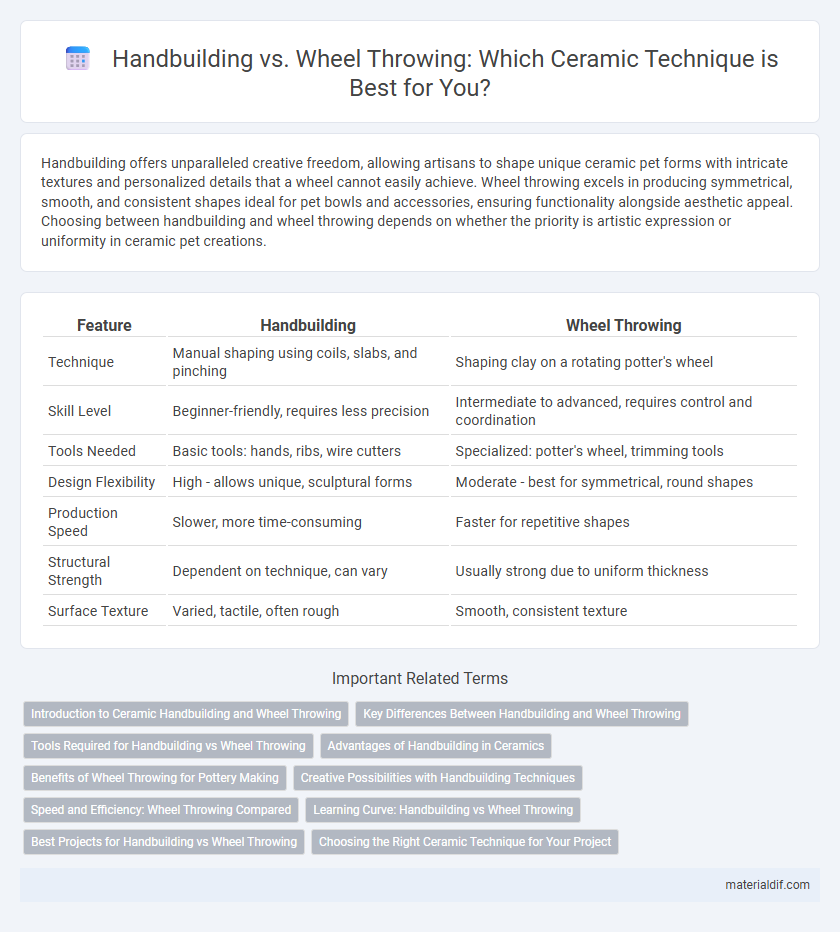Handbuilding offers unparalleled creative freedom, allowing artisans to shape unique ceramic pet forms with intricate textures and personalized details that a wheel cannot easily achieve. Wheel throwing excels in producing symmetrical, smooth, and consistent shapes ideal for pet bowls and accessories, ensuring functionality alongside aesthetic appeal. Choosing between handbuilding and wheel throwing depends on whether the priority is artistic expression or uniformity in ceramic pet creations.
Table of Comparison
| Feature | Handbuilding | Wheel Throwing |
|---|---|---|
| Technique | Manual shaping using coils, slabs, and pinching | Shaping clay on a rotating potter's wheel |
| Skill Level | Beginner-friendly, requires less precision | Intermediate to advanced, requires control and coordination |
| Tools Needed | Basic tools: hands, ribs, wire cutters | Specialized: potter's wheel, trimming tools |
| Design Flexibility | High - allows unique, sculptural forms | Moderate - best for symmetrical, round shapes |
| Production Speed | Slower, more time-consuming | Faster for repetitive shapes |
| Structural Strength | Dependent on technique, can vary | Usually strong due to uniform thickness |
| Surface Texture | Varied, tactile, often rough | Smooth, consistent texture |
Introduction to Ceramic Handbuilding and Wheel Throwing
Ceramic handbuilding involves shaping clay using fingers and simple tools, emphasizing techniques such as pinching, coiling, and slab construction to create unique, textured forms without a potter's wheel. Wheel throwing utilizes a spinning wheel to shape clay symmetrically, enabling precise control over form and thickness for functional pieces like bowls and vases. Understanding the fundamental differences in technique and equipment helps artists choose between the tactile, intuitive process of handbuilding and the speed and symmetry of wheel throwing in ceramics.
Key Differences Between Handbuilding and Wheel Throwing
Handbuilding allows for greater creative freedom by shaping clay manually using techniques like pinching, coiling, and slab construction, ideal for irregular or sculptural forms. Wheel throwing offers precision and symmetry through rapid spinning on a potter's wheel, producing uniform, rounded pieces such as bowls, vases, and pots. Key differences include the skill set required, speed of production, and the types of ceramic objects best suited for each method.
Tools Required for Handbuilding vs Wheel Throwing
Handbuilding ceramics primarily requires basic tools such as clay, a needle tool, rib, wire cutter, and rolling pin, making it accessible and versatile for creating unique forms. Wheel throwing demands a pottery wheel, bats, throwing ribs, and a specialized trimming tool, essential for shaping symmetrical vessels efficiently. Each technique's toolset directly influences the precision, style, and complexity of the ceramic pieces produced.
Advantages of Handbuilding in Ceramics
Handbuilding in ceramics offers greater creative freedom by allowing artists to sculpt unique, organic shapes that are difficult to achieve on a wheel. This technique requires minimal equipment, making it accessible for beginners and ideal for small studios or home use. The tactile process enhances control over texture and detail, resulting in highly individualized ceramic pieces.
Benefits of Wheel Throwing for Pottery Making
Wheel throwing offers precise control over symmetrical forms, making it ideal for creating uniform pottery pieces with consistent wall thickness. This technique significantly speeds up production compared to handbuilding, allowing potters to craft multiple items efficiently. The dynamic nature of wheel throwing also encourages experimentation with circular shapes and innovative surface textures, enhancing artistic expression.
Creative Possibilities with Handbuilding Techniques
Handbuilding techniques in ceramics unlock vast creative possibilities by allowing artists to manipulate clay with unparalleled freedom, enabling the creation of complex textures, asymmetrical forms, and sculptural elements that are difficult to achieve on a wheel. Unlike wheel throwing, which primarily produces symmetrical and rounded shapes, handbuilding supports intricate designs through pinching, coiling, and slab construction methods. This versatility promotes experimentation and personal expression, expanding the artistic potential beyond conventional pottery shapes.
Speed and Efficiency: Wheel Throwing Compared
Wheel throwing offers significantly faster production rates compared to handbuilding, enabling potters to create multiple symmetrical pieces in a shorter timeframe. The mechanical advantage of the potter's wheel allows for greater efficiency, especially in repetitive tasks like forming bowls or cups. While handbuilding provides artistic flexibility, wheel throwing dominates in speed and uniformity for large-scale ceramic production.
Learning Curve: Handbuilding vs Wheel Throwing
Handbuilding offers a gentler learning curve, allowing beginners to develop fundamental ceramic skills through simple techniques like pinching, coil building, and slab construction. Wheel throwing requires more precise motor control and timing, often demanding longer practice periods to master centering and pulling clay on the wheel. Mastering wheel throwing can lead to faster production but involves a steeper initial learning challenge compared to the more intuitive process of handbuilding.
Best Projects for Handbuilding vs Wheel Throwing
Handbuilding techniques excel in creating unique, sculptural pieces such as textured bowls, coil pots, and asymmetrical vases that emphasize artistic expression and intricate detail. Wheel throwing is best suited for symmetrical, functional items like plates, standard bowls, and uniform mugs, offering speed and precision in producing consistent shapes. Projects requiring volumetric stability and complex forms often benefit from combining both methods for optimal results.
Choosing the Right Ceramic Technique for Your Project
Handbuilding ceramic techniques offer greater flexibility for sculptural and intricate designs, making them ideal for unique, custom pieces or asymmetrical forms. Wheel throwing excels in producing uniform, symmetrical vessels quickly, perfect for functional pottery like bowls, cups, and plates. Selecting the right ceramic technique depends on the desired shape, texture, and production scale, with handbuilding favored for artistic expression and wheel throwing chosen for efficiency and consistency.
Handbuilding vs Wheel Throwing Infographic

 materialdif.com
materialdif.com